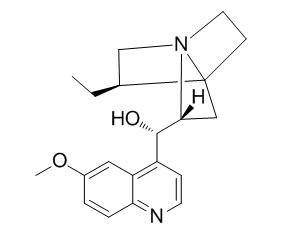Hydroquinidine
Hydroquinidine can prevents life-threatening arrhythmic events in patients with short QT syndrome.
Inquire / Order:
manager@chemfaces.com
Technical Inquiries:
service@chemfaces.com
Tel:
+86-27-84237783
Fax:
+86-27-84254680
Address:
1 Building, No. 83, CheCheng Rd., Wuhan Economic and Technological Development Zone, Wuhan, Hubei 430056, PRC
Providing storage is as stated on the product vial and the vial is kept tightly sealed, the product can be stored for up to
24 months(2-8C).
Wherever possible, you should prepare and use solutions on the same day. However, if you need to make up stock solutions in advance, we recommend that you store the solution as aliquots in tightly sealed vials at -20C. Generally, these will be useable for up to two weeks. Before use, and prior to opening the vial we recommend that you allow your product to equilibrate to room temperature for at least 1 hour.
Need more advice on solubility, usage and handling? Please email to: service@chemfaces.com
The packaging of the product may have turned upside down during transportation, resulting in the natural compounds adhering to the neck or cap of the vial. take the vial out of its packaging and gently shake to let the compounds fall to the bottom of the vial. for liquid products, centrifuge at 200-500 RPM to gather the liquid at the bottom of the vial. try to avoid loss or contamination during handling.
Korean Herb. Med. Inf. 2016, 4(1):35-42
JMicrobiol Biotech Food Sci2021, e4289.
Korean J. Medicinal Crop Sci.2022, 30(2):117-123.
Separations2023, 10(4),255.
Nutrients2020, 12(3):811.
BMC Plant Biol.2020, 20(1):214.
Heliyon.2024, 10(7):e28755.
Biomol Ther (Seoul).2023, 31(1):40-47.
J Ethnopharmacol.2020, 269:113752.
Molecules2020, 25(4):892
Related and Featured Products
J Am Coll Cardiol. 2017 Dec 19;70(24):3010-3015.
Hydroquinidine Prevents Life-Threatening Arrhythmic Events in Patients With Short QT Syndrome.[Pubmed:
29241489]
Short QT syndrome (SQTS) is a rare and life-threatening arrhythmogenic syndrome characterized by abbreviated repolarization. Hydroquinidine (HQ) prolongs the QT interval in SQTS patients, although whether it reduces cardiac events is currently unknown. This study investigated whether long-term treatment with HQ reduces the occurrence of life-threatening arrhythmic events (LAE) (cardiac arrest or sudden cardiac death) in SQTS patients.
METHODS AND RESULTS:
In this cohort study on consecutive SQTS patients, 2 analyses were performed: 1) a matched-period analysis for the occurrence of LAE in 17 SQTS patients who received long-term HQ; and 2) a comparison of the annual incidence of LAE off- and on-HQ in 16 SQTS patients who survived a cardiac arrest. A total of 17 patients (82% male, age 29 ± 3 years, QTc before treatment 331 ± 3 ms) received HQ therapy (584 ± 53 mg/day). Therapy was stopped in 2 cases (12%) due to gastrointestinal intolerance, and 15 patients continued treatment for 6 ± 1 year. QTc prolongation was observed in all patients (by 60 ± 6 ms; p < 0.001). We compared the occurrence of LAE during 6 ± 1 years before and after HQ, observing that patients on HQ experienced a reduction in both the rate of LAE from 40% to 0% (p = 0.03) and the number of LAE per patient from 0.73 ± 0.3 to 0 (p = 0.026). Furthermore, the annual rate of LAE in the 16 patients with a previous cardiac arrest dropped from 12% before HQ to 0 on therapy (p = 0.028).
CONCLUSIONS:
We demonstrated for the first time that treatment with HQ was associated with a lower incidence of LAE in SQTS patients. These data point to the importance that quinidine, that in several countries has been removed from the market, remains available worldwide for patients with SQTS. In the present study, therapy with HQ has been proven to be safe, with a relatively low rate of side effects.
Cardiovasc Drugs Ther. 1997 Jul;11(3):493-8.
Relationships between heart rate variability and antiarrhythmic effects of hydroquinidine.[Pubmed:
9310279]
Class I antiarrhythmic drugs may increase the incidence of cardiac death, and controlled treatment is required in patients with severe ventricular arrhythmias. Electrophysiologically guided antiarrhythmic therapy remains an important method to manage patients with sustained ventricular tachycardia (VT). The purpose of the study was to evaluate the correlations between baseline heart rate variability in ambulatory electrocardiographic recordings of patients with sustained ventricular tachycardia and the response to Hydroquinidine on VT inducibility, and to look for the changes in heart rate variability during Hydroquinidine treatment.
METHODS AND RESULTS:
Thirty-five patients with spontaneous and inducible sustained VT were studied. Programmed ventricular stimulation and time and frequency domain analysis of heart rate variability were studied in the control state and 9–12 days after treatment with 300–600 mg of Hydroquinidine. In 11 patients (group I), Hydroquinidine prevented VT induction. In 24 patients (group II), sustained VT remained inducible during treatment with Hydroquinidine. In the control state, heart rate variability was similar in both groups. During treatment with Hydroquinidine, heart rate variability tended to decrease in groups I and II, but the changes were significant only in group II: the coefficient of variance (CV) decreased from 13 ± 4% to 10% ± 3% (p > 0.01) and low frequency/high frequency amplitude ratio decreased from 4.6 ± 3.3 to 2.87 ± 2.42 (p > 0.05).
CONCLUSIONS:
In conclusion, baseline heart rate variability does not differentiate the responders and nonresponders to Hydroquinidine. Hydroquinidine decreases heart rate variability in all patients, but principally in those with still inducible VT.



